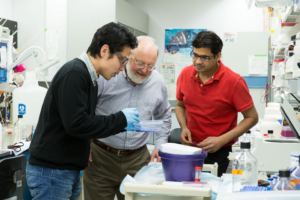 How does aspirin work in your body?
How does aspirin work in your body?
Daniel Klessig, professor in the Boyce Thompson Institute at Cornell University, examines how this widely used drug goes to work.
Dr. Klessig’s early research career, which started as a graduate student with Nobel
Laureate James Watson, focused on the molecular biology of human adenovirus. His studies of
this DNA tumor virus resulted in a molecular explanation for the failure of pharmaceutical
companies to produce adenovirus vaccines in monkey cells in the 1950s. This work also
provided some of the first evidence for split genes and led him to propose in 1977 that mRNAs
in animals are produced by a process of RNA splicing (intra-molecular ligation). While
continuing to study adenoviruses until 1996, he initiated a research program in plant molecular
biology in the early 1980’s.
The goal of his ongoing research is to understand how plants protect themselves against
microbial pathogens. Over the past decades he and his research team identified components in
pathways, which enable plants to recognize that they are being attacked in order for them to
rapidly mount defenses against the invader. Their efforts resulted in the identification of two
critical defense-signaling molecules in plants – salicylic acid (SA) and nitric oxide (NO).
Interestingly, both SA and NO also play roles in human health. NO is a potent endogenous
signaling molecule in human, where it plays critical roles in inflammatory and immune
responses, in neural transmission, and in muscle physiology. Dr Klessig’s work demonstrated
that several critical players of animal NO signaling are also operative in plants during their
response to pathogen assault. In 1990s Klessig and coworkers also discovered the importance
of SA in plants by demonstrating that it is a hormone produced by plants to activate their
immune systems.
Their subsequent studies identified a long-sought mobile signal for development of a state of heightened defense, which is activated throughout a plant after an initial infection, called systemic acquired resistance. This signal is methyl salicylate, a modified and inactive form of SA. Their research also revealed that, in contrast to most hormones in plants and animals, SA acts through many different protein targets to mediate its many effects on immunity and other plant processes.
Interestingly, derivatives of SA, including aspirin (acetyl SA), have been used by humans for thousands of years to treat a variety of maladies. The prevailing view in the biomedical community has been that aspirin, the most widely use drug worldwide for over a century, works primarily, if not exclusively, by irreversibly inhibiting the enzymatic activities of cyclooxygenases 1 and 2 (COX1 and COX2), However, aspirin is rapidly converted in the body to SA, which has similar pharmacological effects as aspirin, despite its poor ability to inhibit the cyclooxygenases. Klessig’s recent studies are addressing this conundrum by revealing several novel targets through which SA mediates its many pharmacological effects.
These targets include High Mobility Group Box1 (HMGB1) and Glyceraldehyde 3-Dehydrogenase (GAPDH). HMGB1, when released outside of cells following tissue injury or secretion by certain immune or cancer cells, has potent pro-inflammatory activities associated with rheumatoid arthritis, atherosclerosis, inflammatory bowel disease, lupus, sepsis, and inflammation-associated cancers such as colorectal and mesothelioma cancers. GAPDH facilitates infection by the hepatitis viruses and is a major suspect in the neurodegenerative diseases Alzheimer’s, Parkinson’s, and Huntington’s. SA binds to both, thereby inhibiting their disease-associated activities.
How Does Aspirin Work?
Acetyl salicylic acid, commonly called aspirin, is the most widely used drug worldwide for more than a century to treat pain, fever, swelling, and more recently to reduce the risk of heart attack, stroke, and certain cancers. The prevailing view is that aspirin works primarily by inhibiting the cyclooxygenases. However, this assumption ignores two important facts. First, aspirin is rapidly converted to salicylic acid in the body. Second, salicylic acid is a poor inhibitor of the cyclooxygenases, yet salicylic acid and aspirin have nearly the same pharmacological effects. Thus, there must be additional targets through which salicylic acid and aspirin exert their many effects.

To find these targets we used high-throughput screens. This strategy identified Glyceraldehyde 3-Phosphate Dehydrogenase, termed GAPDH for short. GAPDH is a major suspect in Alzheimer’s and Parkinson’s diseases. GAPDH plays a key role in a novel cell death pathway, which involves GAPDH movement into the nucleus. This results in neuronal cell death.
We discovered that GAPDH binds salicylic acid, which suppresses its nuclear translocation and the resulting cell death. Importantly, we also identified synthetic and natural salicylic acid derivatives that inhibit GAPDH nuclear translocation and cell death more effectively than salicylic acid. These derivatives also are much more potent inhibitors of our second newly identified target of aspirin – HMGB1, which is involved in inflammation-associated diseases such as arthritis, heart disease, certain cancers and also Alzheimer’s.


